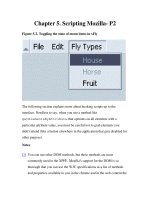Tài liệu Creating a Class That Participates in an Automatic Transaction ppt
Bạn đang xem bản rút gọn của tài liệu. Xem và tải ngay bản đầy đủ của tài liệu tại đây (27.91 KB, 5 trang )
[ Team LiB ]
Recipe 6.1 Creating a Class That Participates in an Automatic Transaction
Problem
You need to create a .NET class that participates in automatic transactions.
Solution
Use the appropriate custom attributes from the System.EnterpriseServices namespace.
The sample contains a component that participates in automatic transactions. The
component has a single method, TranTest( ) , that instructs the transaction to succeed or
fail based on an argument success.
The sample also contains code that instantiates the component that participates in the
automatic transaction. A checkbox on the form is used to specify the success parameter
when the TranTest( ) method is called.
The C# code is shown in Examples Example 6-1
and Example 6-2.
Example 6-1. ServicedComponentCS Project File: SC0601.cs
// Namespaces, variables, and constants
using System.EnterpriseServices;
using System.Runtime.CompilerServices;
using System.Reflection;
// . . .
namespace AdoDotNetCookbookCS.ServicedComponentCS
{
[Transaction(TransactionOption.Required)]
public class SC0601 : ServicedComponent
{
[AutoComplete]
public void TranTest(bool success)
{
// . . . Do some work.
if(success)
{
// don't need the next line since AutoComplete
// ContextUtil.SetComplete( );
}
else
{
// Vote to abort.
ContextUtil.SetAbort( );
// Raise an exception.
throw new System.Exception(
"Error in Serviced Component 0601. " +
"Transaction aborted.");
}
}
}
}
Example 6-2. File: AutoTransactionForm.cs
// Namespaces, variables, and constants
using System;
using System.Windows.Forms;
using AdoDotNetCookbookCS.ServicedComponentCS;
// . . .
SC0601 sc = new SC0601( );
try
{
sc.TranTest(transactionSucceedCheckBox.Checked);
MessageBox.Show("Transaction successful.", "Automatic Transactions",
MessageBoxButtons.OK, MessageBoxIcon.Information);
}
catch(Exception ex)
{
MessageBox.Show(ex.Message, "Automatic Transactions",
MessageBoxButtons.OK, MessageBoxIcon.Error);
}
Discussion
The .NET Common Language Runtime (CLR) supports both manual and automatic
transaction models. The automatic distributed transaction model supported by the .NET
CLR is the same as that supported by Microsoft Transaction Server (MTS) and COM+.
The .NET Framework provides support for transactional components through the
EnterpriseServices namespace that provides .NET objects with access to COM+ services.
There are two key benefits to automatic transactions:
•
They support distributed transactions that span multiple remote databases and
multiple resource managers.
•
Objects participating in automatic transactions do not need to anticipate how they
might be used within a transaction. A client can perform different tasks with
multiple objects, all in the context of a single transaction, without the participating
objects being aware of the transaction.
The main drawback is:
•
Additional overhead because of the interaction with the Distributed Transaction
Coordinator (DTC) and the resulting reduction in performance.
During the lifetime of an automatic transaction, the objects participating in it can vote to
either commit the transaction they are participating in by calling the static SetComplete( )
method of the ContextUtil class or to abort the transaction by calling the static SetAbort(
) method of the ContextUtil class. In the absence of an explicit vote, the default is to
commit the transaction. The transaction is committed once it completes if none of the
participating objects have voted to abort.
Alternatively, you can apply the AutoCompleteAttribute attribute to a transactional
method. This attribute instructs .NET to vote to commit the transaction, provided no
exceptions are encountered in the method. If an unhandled exception is thrown, the
transaction is automatically rolled back.
The .NET Framework classes must be prepared before they can participate in an
automatic transaction. Once an object is marked to participate in a transaction, it will
automatically execute within a transaction. The object's transactional behavior is
controlled by the value of the transaction attribute for the .NET class, ASP.NET page, or
XML web service method using the object. This allows the instantiated object to be
configured programmatically to participate automatically in an existing transaction, to
start a new transaction, or to not participate in a transaction. The following steps prepare
a class to participate in an automatic transaction:
1. Derive the class from the ServicedComponent class in the
System.EnterprisesServices namespace.
2. Apply the declarative TransactionAttribute to the class and specify the transaction
behavior, timeout, and isolation level. This is a value from the TransactionOption
enumeration described in Table 6-1
.
Table 6-1. TransactionOption Enumeration
Value Description
Disabled
Automatic transactions do not control the object:
[Transaction(TransactionOption.Disabled)]
NotSupported
The object does not run in the scope of transactions:
[Transaction(TransactionOption.NotSupported)]
Supported
The object runs in context of an existing transaction, if one exists. The
object runs without a transaction if one does not exist.
[Transaction(TransactionOption.Supported)]
Required
The object requires a transaction and runs in context of an existing
transaction, if one exists. The object starts a transaction if one does not
exist.
[Transaction(TransactionOption.Required)]
RequiresNew
The object requires a transaction. A new transaction is started for each
request.
[Transaction(TransactionOption.RequiresNew)]
3. Optionally annotate methods with the AutoComplete attribute so that the methods
do not have to explicitly vote for a transaction outcome.
4. Sign the assembly with a strong name. Use the sn.exe utility to create a key pair
using the following syntax:
sn -k MyApp.snk
Add the AssemblyKeyFileAttribute or AssemblyKeyNameAttribute assembly
attribute to specify the file containing the key pair. The following code is used in
the solution to sign the assembly:
[assembly: AssemblyDelaySign(false)]
[assembly: AssemblyKeyFile(
@"C:\ADOCookbookCS\ServicedComponentCS\" +
"AdoDotNetCookbookCSServicedComponent.snk")]
[assembly: AssemblyKeyName("AdoDotNetCookbookCSServicedComponent")]
5. Register the assembly containing the class with the COM+ catalog by executing
the .NET Services Registration Tool (regsvcs.exe) with the following syntax:
regsvcs /appname:MyApp MyAssembly.dll
This step isn't strictly required. If a client calling the class is managed by the CLR,
the registration will be performed automatically.
[ Team LiB ]









